Are you looking for a sunny getaway to leave the drab, cold weather in the UK or northern Europe for a while? Look no further than Fuerteventura, the second largest of Spain’s Canary Islands.
This desert-like paradise boasts over 150 km of gorgeous white sand beaches, making it a top holiday destination for year-round sun-seekers.

Fuerteventura is just off the coast of Africa in the Atlantic Ocean, blessed with warm weather and stunning landscapes. From vast sand dunes to volcanic shores, the island offers diverse natural wonders to explore.
Whether you’re after a relaxing beach holiday or an action-packed adventure, holidays to Fuerteventura have something for everyone. You can soak up the sun on pristine white sands, try your hand at water sports, or visit charming villages to soak in the local culture.
With its natural beauty and fun activities, Fuerteventura is sure to capture your heart. It certainly did mine when I first visited in 1987.
The Island’s Geography and Climate
Fuerteventura’s unique landscape and sunny climate make it a paradise for beach lovers and outdoor enthusiasts. The island has a mix of volcanic features and stunning beaches.
The Unique Landscape of Fuerteventura, Canary Islands
Fuerteventura’s geography is a blend of volcanic hills and sandy shores. The island stretches about 100 km from north to south. Dark volcanic rocks dot the landscape, a reminder of its fiery past.
The island’s coastline is a treasure trove of beautiful beaches. Golden and white sands stretch for kilometres, perfect for sunbathing and water sports.
You will discover rolling dunes that give Fuerteventura a desert-like feel. The wind constantly shapes these sand formations, creating an ever-changing landscape.
Climate: Sun-Drenched Days Await
Fuerteventura boasts a warm, dry climate year-round. You can expect plenty of sunshine, with over 3,000 hours annually!
The mild temperatures rarely drop below 18°C or rise above 32°C, making it a great escape in any season.
Rainfall is scarce, with less than 150mm per year. The island’s location near Africa contributes to its arid climate.
Cool sea breezes help keep things comfortable, especially in the summer months. They also create ideal conditions for windsurfing and kiteboarding.
A Visitor’s Guide to Fuerteventura’s Towns and Resorts
Fuerteventura offers diverse towns and resorts, each with its unique charm. From lively beach destinations to quiet historical villages, you will find the perfect spot for your holiday.
Corralejo: A Vibrant Resort Town
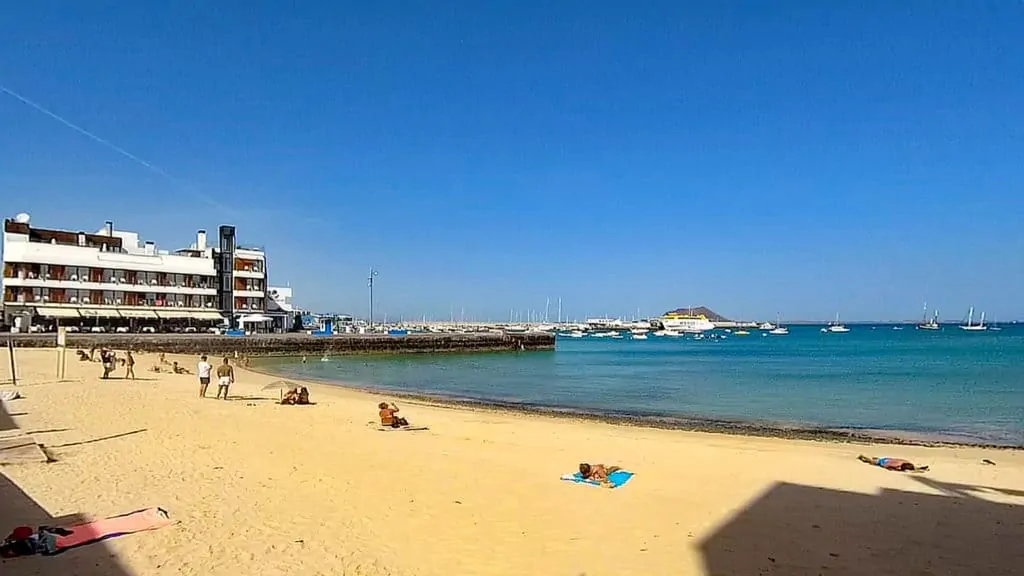
Corralejo is Fuerteventura’s most popular resort town. It’s bustling with energy and packed with things to do. You’ll love the golden sandy beaches and crystal-clear waters.
The town centre is full of shops, restaurants, and bars. It’s perfect for those who want a lively nightlife.
Corralejo is famous for its stunning sand dunes. These natural wonders stretch for miles and are a must-see.
Water sports fans will be in heaven here. You can try surfing, windsurfing, or kitesurfing.
The harbour area is lovely for evening strolls. You can watch the sunset while enjoying a meal at one of the seafront restaurants.
El Cotillo: Perfect for Relaxing
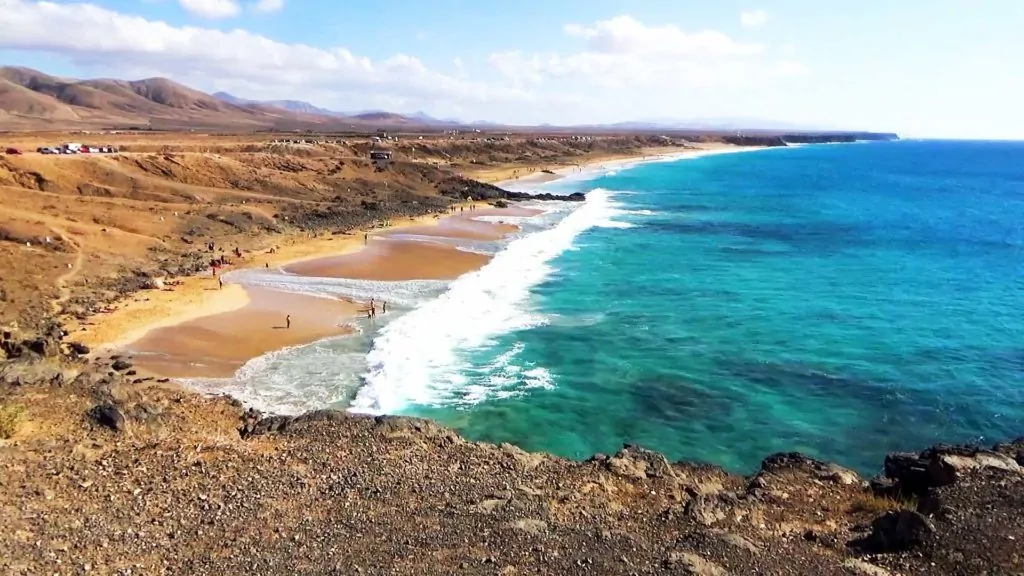
El Cotillo is a small fishing village on the northwest coast. It’s ideal for a peaceful getaway.
The village is known for its beautiful lagoons. These shallow pools are perfect for swimming and sunbathing.
Here, there are some of the island’s best seafood restaurants. Fresh fish is caught daily and served in local eateries.
The old harbour is picturesque and worth exploring. It’s an excellent spot for photos.
Surfers flock to the town for its excellent waves. Even if you don’t surf, watching the pros is fun.
Caleta de Fuste: Family-Friendly Fun
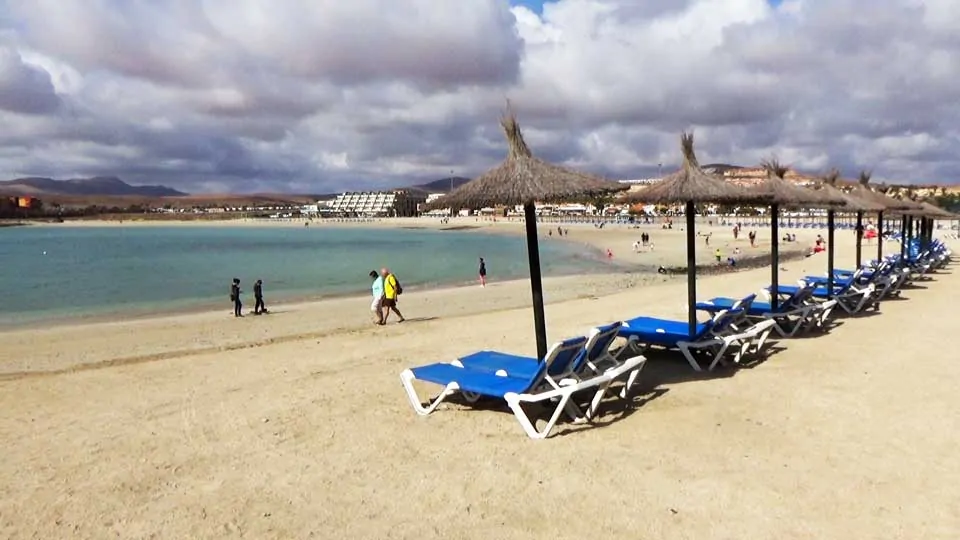
Caleta de Fuste is a purpose-built resort great for families. The two man-made and sheltered beaches are safe for kids.
Plenty of family-friendly restaurants and bars are dotted around the town. Many offer kids’ menus and play areas. The town has a good selection of shops and supermarkets, making self-catering holidays easy.
Two golf courses are nearby if you fancy a round. The marina is also worth a visit, and boat trips are available.
Water sports are popular here, too. You can try jet-skiing, banana boating, or pedalo rides.
Costa Calma: Great Hotels
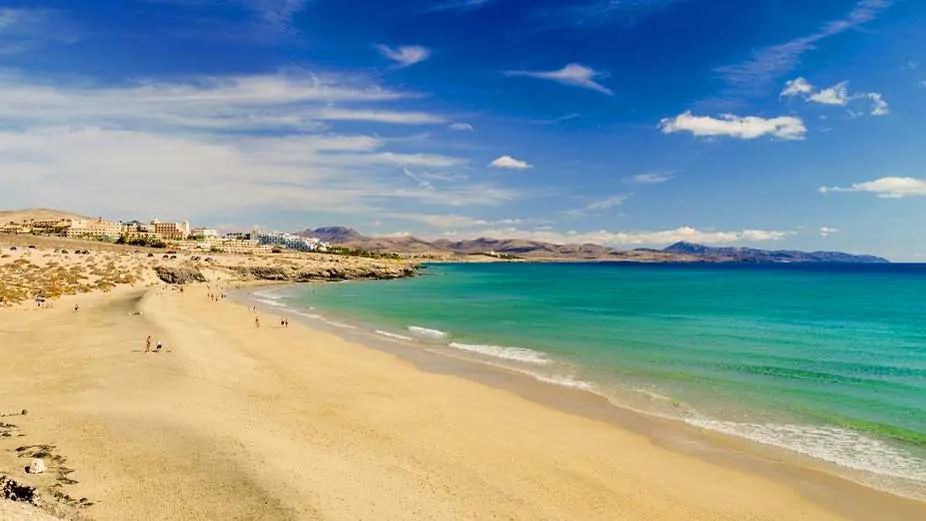
Costa Calma lives up to its name – it’s a calm and relaxing place. The beach here is long and beautiful, with white sand and turquoise water. Windsurfing is popular here due to the steady winds. You can take lessons if you’re a beginner.
You will find some of Fuerteventura’s best hotels in Costa Calma. Many offer all-inclusive packages.
The town is quieter than some other resorts. It’s perfect if you want to unwind and de-stress.
There’s a market every Sunday where you can buy local crafts and food. It’s a great place to pick up souvenirs.
Morro Jable/Jandia: Amazing Beaches
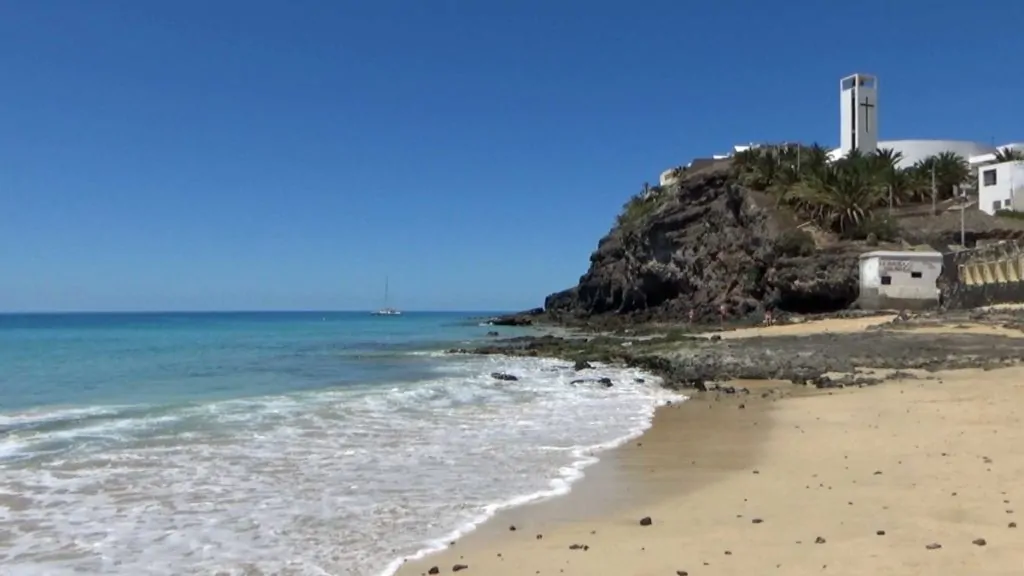
Morro Jable and Jandia are often talked about together. They’re at the southern tip of Fuerteventura.
The beaches here are some of the best on the island. They stretch for miles and are rarely crowded. Water sports are big here, too. The windsurfing conditions are excellent.
Morro Jable has a lovely old town area. Wander the narrow streets and enjoy the local atmosphere. Jandia is home to a nature park. It’s excellent for hiking and spotting local wildlife.
The area is popular with German tourists, so there are many German restaurants and bars.
Puerto del Rosario: The Island’s Capital

Puerto del Rosario is Fuerteventura’s capital city. It’s not as touristy as other towns, but it’s worth a visit.
The city is known for its sculptures. You can spot over 100 dotted around the streets.
There’s a nice, safe beach right in the city centre. It’s a great spot for a quick dip.
The Unamuno House Museum is dedicated to a famous Spanish writer exiled here. It offers information about local history.
The main indoor shopping mall, the Rotundas, is good for retail therapy. It features both local and international brands.
Betancuria: A Glimpse into the Past
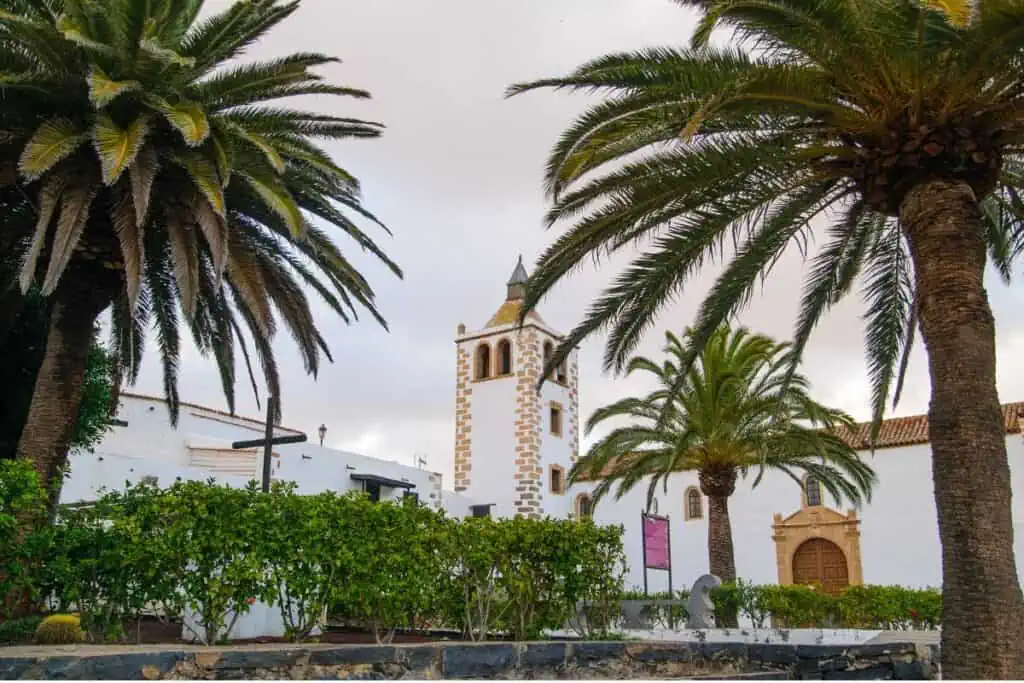
Betancuria is a small village in the heart of Fuerteventura. It was once the capital of the island. The village is full of history. You can visit the 17th-century church of Santa Maria.
There is a museum in a beautiful old building where you can learn about Fuerteventura’s past.
The surrounding countryside is stunning. It’s an excellent area for walking and cycling.
Betancuria is much cooler than the coastal areas. This makes it a nice escape on hot days.
The town has some lovely restaurants serving traditional Canarian food, making it a great place to try local dishes.
Fuerteventura’s Stunning Beaches
The coast of Fuerteventura boasts some of Spain’s most beautiful beaches. With golden sands and clear waters, the island offers a perfect mix of lively and secluded spots for sun-seekers and water enthusiasts alike.
Corralejo’s Sand Dunes
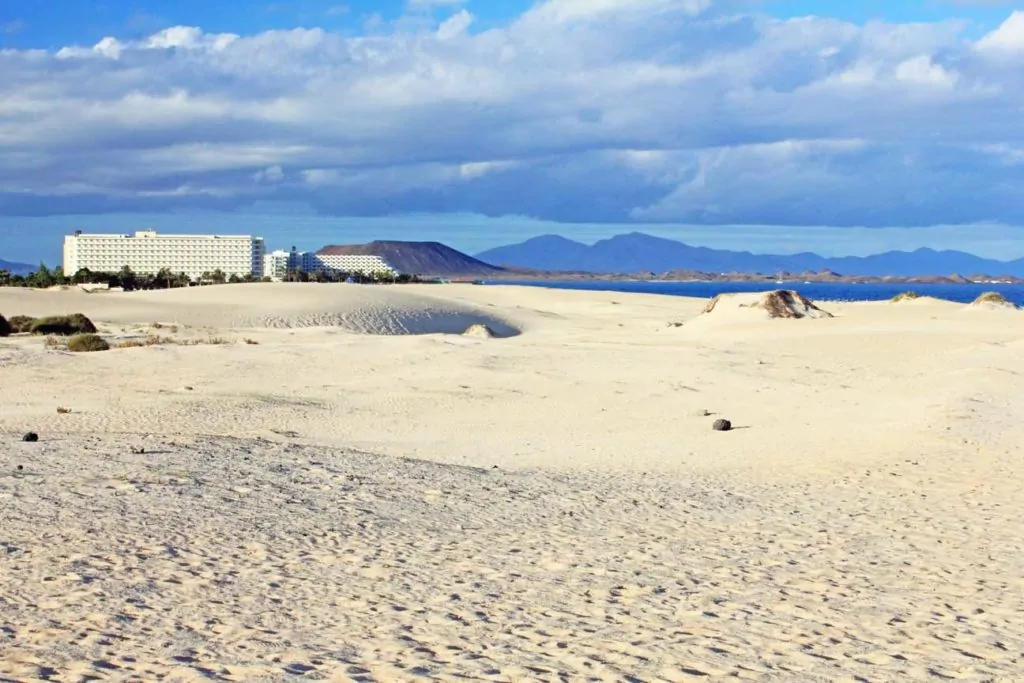
The Corralejo Natural Park is home to vast sand dunes that stretch for miles. These golden hills meet the turquoise sea, creating a stunning landscape. There is plenty of space to sunbathe or take a leisurely stroll along the shore.
The main beach, Flag Beach, is well-equipped with sunbeds and umbrellas for hire. Water sports are popular here, with kitesurfing and windsurfing schools dotting the coastline.
For a quieter experience, head to the more remote parts of the dunes. Here, you can enjoy the untouched beauty of the area in peace.
Playa de Sotavento: A Watersports Paradise
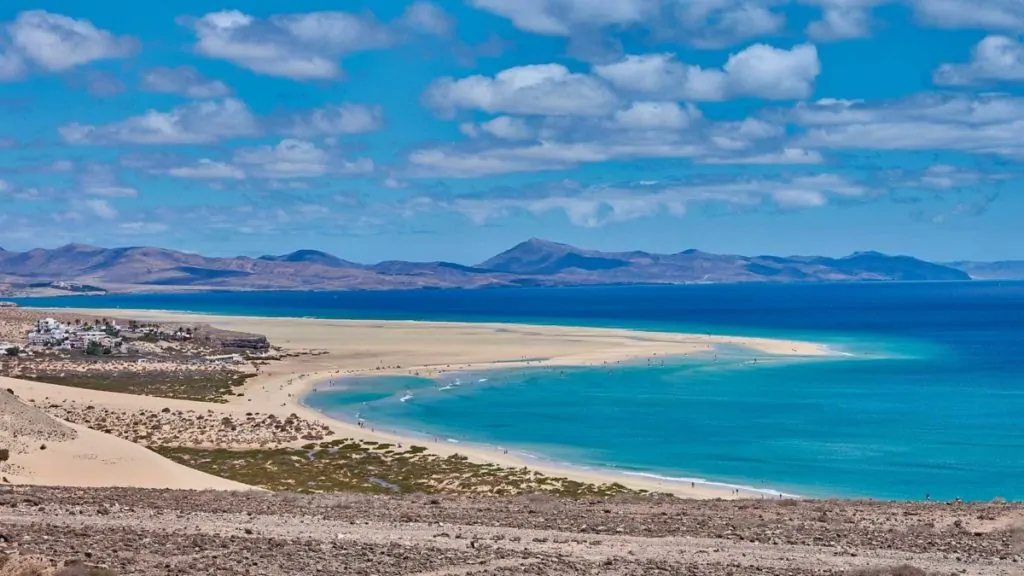
Playa de Sotavento is a long stretch of white sand on Fuerteventura’s south-eastern coast. It’s a haven for water sports enthusiasts, especially windsurfers and kiteboarders.
The beach’s shallow lagoon forms at low tide, creating ideal conditions for beginners to practice. More experienced riders can venture further out to catch the stronger winds.
Even if you’re not into water sports, Sotavento is worth a visit. The beach’s pristine sands and crystal-clear waters make it perfect for swimming and sunbathing.
The entire stretches of beach in this area are perfect for naturists. Read: Best beaches for naturists in Fuerteventura.
The Serenity of Cofete
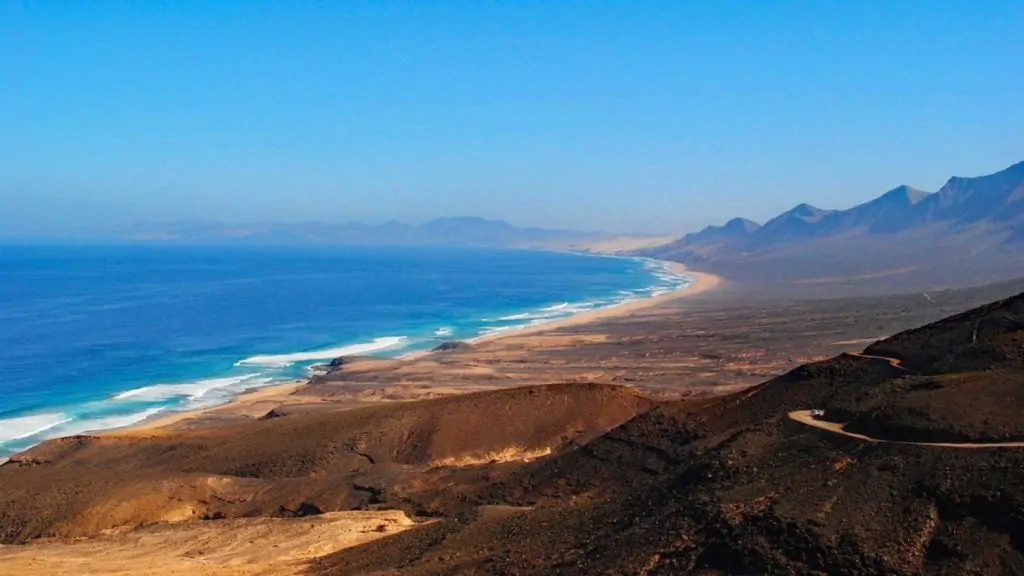
Cofete Beach is a hidden gem on Fuerteventura’s rugged southwest coast. The dramatic Jandia mountains frame this remote 12-kilometre stretch of golden sand.
The beach’s wild beauty and isolation make it a favourite among nature lovers. Strong currents mean swimming isn’t advised, but the views are spectacular.
To reach Cofete, you’ll need to drive along a bumpy dirt road. The journey is part of the adventure, and the reward is one of the most unspoilt beaches in Europe.
Pack a picnic and plenty of water, as there are no facilities on this secluded beach. Don’t forget your camera – the scenery is truly breathtaking.
Adventure Sports and Activities
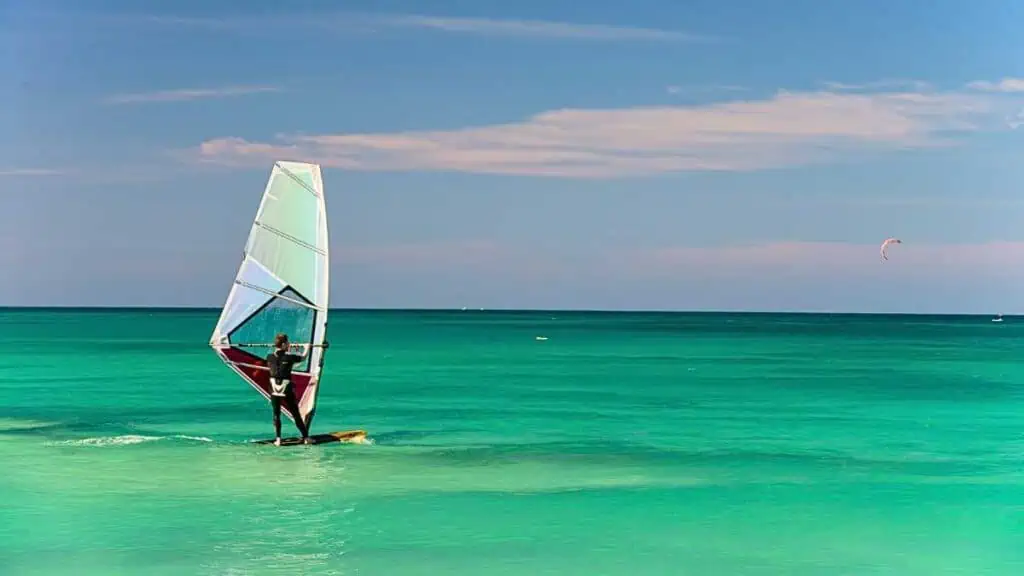
Fuerteventura offers thrilling experiences for sports enthusiasts. The island’s natural features create perfect conditions for various exciting activities.
Catch a Wave: Surfing on Fuerteventura
Fuerteventura is a surfer’s paradise. The island boasts over 150 km of coastline with waves suitable for all skill levels.
Beginners can start at Playa del Moro or El Cotillo, where gentle waves and sandy bottoms make learning easier. These spots often have surf schools nearby.
The North Shore is a must-visit for experienced surfers. Spots like El Hierro and Shooting Gallery offer powerful waves and challenging conditions.
The best time for surfing is between October and March when the swells are bigger. Remember to pack a wetsuit, as the water can be chilly.
Windsurfing: Harnessing the Atlantic Winds
Windsurfing is hugely popular in Fuerteventura thanks to its steady winds and warm waters. Sotavento Beach is a top spot, hosting world championship events.
Beginners can try Flag Beach or Corralejo, where shallow waters and lighter winds make learning easier. Many schools offer lessons and equipment hire.
For more experienced windsurfers, head to Playa de Jandía. There are stronger winds and bigger waves for an adrenaline-pumping session here.
The best time for windsurfing is between May and September, when the winds are strongest. Always check local conditions before heading out.
Diving into the Deep: Scuba Experiences
Fuerteventura’s clear waters and rich marine life make it a fantastic place for scuba diving. The island has dive sites suitable for all levels.
Beginners can explore the calm waters of Caleta de Fuste. This area has shallow reefs teeming with colourful fish and octopuses.
More experienced divers should check out the Majanicho caves or the wreck of the American Star. These sites offer stunning underwater landscapes and diverse marine life.
The best time for diving is between June and October when the water is warmest. Always dive with a reputable company and follow local safety guidelines.
Golf Year Round in Fuerteventura
Fuerteventura’s mild climate makes it perfect for year-round golfing. The island boasts several top-notch courses with stunning ocean views.
Fuerteventura Golf Club in Caleta de Fuste is an 18-hole championship course that hosted the Spanish Open a few years ago. Its strategically placed bunkers and water hazards make the game challenging. Next to this course is the Salinas de Antigua Golf Club.
Jandia Golf Course is the longest on the island and is quite hilly.
Try the Playitas Golf Club for a more relaxed game with great sea views. It’s ideal for beginners or those looking for a quicker round.
Remember to book tee times in advance, especially during peak tourist seasons. Most clubs offer equipment hire if you don’t want to bring your own.
Cultural Insights: Traditions and Local Cuisine

Fuerteventura’s rich culture shines through its unique traditions and mouthwatering local dishes. This island is truly special because it blends Canarian customs and flavours.
Majorero Cheese and Other Culinary Delights
Majorero cheese is a true star of Fuerteventura’s cuisine. This creamy delicacy is made from goat’s milk and has a Protected Designation of Origin status. It can be tasted fresh or cured and is often paired with local wines.
Mojo sauce is another must-try. This zesty condiment comes in red (spicy) or green (mild) varieties and is a classic Canarian side dish that goes well with wrinkled Canarian potatoes. Of course, many restaurants offer great Tapas.
For a taste of the sea, try lapas (limpets) or fresh fish like parrotfish. Seafood plays a big role in the island’s diet.
Don’t miss out on gofio, a toasted grain flour used in many dishes. It’s a staple food with a long history on the island.
Folklore and Festivals: The Canarian Spirit
Fuerteventura’s festivals are a feast for the senses. The Corralejo Carnival, held in February or March, is a lively event with colourful parades and music.
You’ll see traditional Canarian clothing at many events. Women often wear long, flowing dresses, while men don white shirts and dark trousers.
Folk music is an integral part of the culture. Listen out for timples and small guitar-like instruments that create a unique island sound.
Religious festivals are common, too. The Fiesta de la Peña, honouring the island’s patron saint, features processions and local food stalls.
These events are great chances to mingle with locals and soak up the Canarian spirit.
Natural Wonders: Parks and Reserves
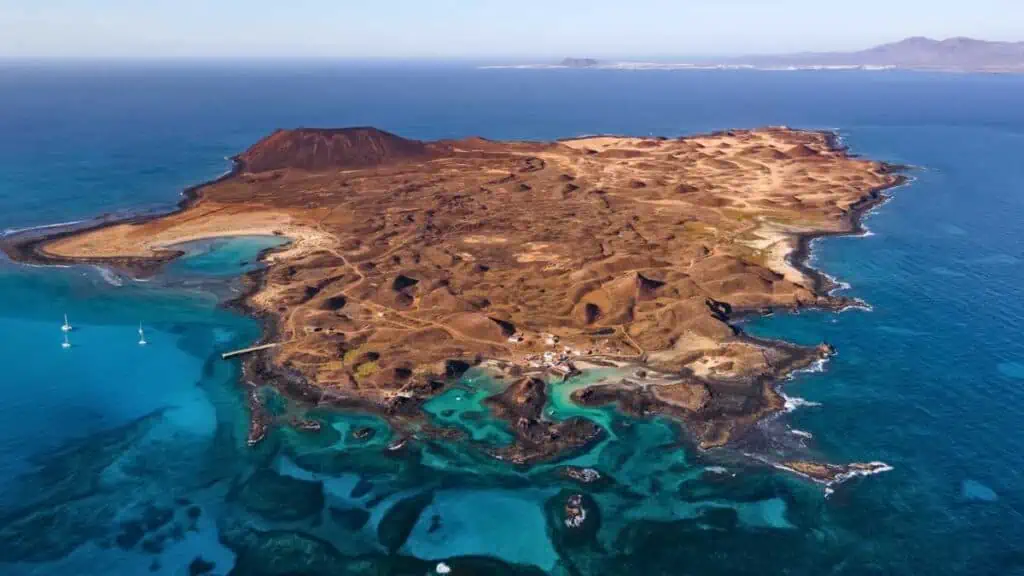
Fuerteventura boasts stunning natural areas that showcase its unique beauty. Explore pristine islands and vast protected landscapes teeming with diverse flora and fauna.
Discovering Lobos Island
Lobos Island is a small nature reserve just off Fuerteventura’s coast. Its crystal-clear waters are perfect for snorkelling and spotting colourful fish. The island’s volcanic landscape offers great hiking trails with amazing views.
Climb to the top of the old lighthouse for a panoramic vista of Fuerteventura and Lanzarote. Keep an eye out for rare birds like the Cory’s shearwater. The island has no permanent residents so you can enjoy its unspoilt beaches peacefully.
Remember to bring water and sun protection, as there are few facilities on Lobos.
Jandía: A Biosphere Reserve by UNESCO
Jandía Peninsula covers the southern tip of Fuerteventura. UNESCO named it a Biosphere Reserve for its unique ecosystems. Its stunning beaches, rugged cliffs, and diverse plant life are also found here.
The reserve is home to many endemic species found nowhere else. Look out for the Canary Islands stonechat and the Fuerteventura giant lizard. Hike to Pico de la Zarza, the island’s highest point for breathtaking views.
Jandía’s beaches are some of the best in Europe. Playa de Cofete offers 12 km of golden sand backed by dramatic mountains. It’s a perfect spot for a peaceful walk or sunbathing.
History and Heritage of Fuerteventura
Fuerteventura’s past is rich with tales of conquest and cultural exchange. The island’s heritage is visible in its architecture and archaeological sites, offering a glimpse into its fascinating history.
From Bethencourt to Modern Times
In 1404, Norman nobleman Jean de Bethencourt arrived on Fuerteventura’s shores. This marked the start of European rule on the island. Bethencourt established the first settlements at Vega de Rio Palmas and Betancuria. It became the island’s first capital.
When Bethencourt arrived, the island had two local kings. They surrendered rather than fought, leading to a fairly peaceful takeover. By 1405, the conquest was complete.
A census in the 1440s showed that about 1,200 people lived on Fuerteventura. Over time, the population grew, and new towns popped up across the island.
Historical Sites and Architecture
As you explore Fuerteventura, you’ll find many traces of its past. The Santa Maria Church in Betancuria is a must-see. Built in the 15th century, it’s one of the oldest churches on the island.
You can also visit ancient sites left by the island’s first inhabitants. Look out for rock carvings and ruins scattered around Fuerteventura.
The island’s architecture tells its own story. As you wander through its towns, you’ll spot charming churches and grand old houses showing off the island’s colonial heritage.
Visit one of Fuerteventura’s museums to learn more about local history. They are a great way to learn about the island’s past and culture.
Travel Essentials: Getting to and Around Fuerteventura
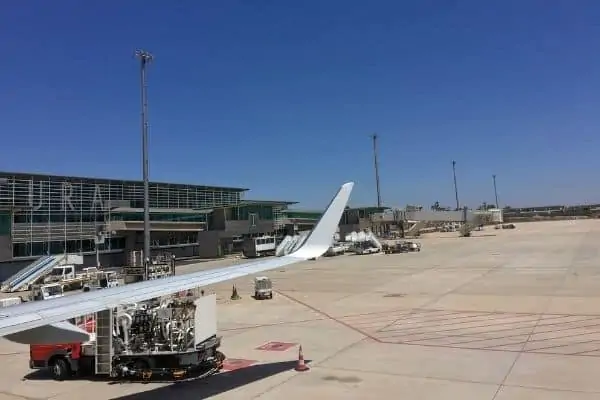
Getting to Fuerteventura and exploring the island is quite straightforward. You have several options for arriving and moving about, including air travel, ferries, buses, and car hire.
Fuerteventura Airport: Your Gateway to the Island
Fuerteventura Airport, located near Puerto del Rosario, is the main entry point for most visitors. It handles flights from many European cities and other Canary Islands. Once you land, you’ll find car hire desks, taxis, and buses to take you to your destination.
Top tips for your arrival:
- Book your transport in advance during peak seasons
- Check if your hotel offers airport transfers
- Consider renting a car at the airport for more freedom
Read: My Fuerteventura Airport Guide
Navigating By Land: Car and Bus Tips
Renting a car is popular for exploring Fuerteventura’s diverse landscapes. The island’s roads are well-maintained and easy to navigate. If you prefer public transport, buses connect major towns and tourist spots.
Car hire advice:
- Book early for better rates
- Choose a small car for easier parking
- Check your insurance coverage
- Read my advice on driving in Fuerteventura
Bus travel tips:
- Buy a multi-journey card for savings
- Check timetables as services can be infrequent
- Bring cash for fares
Inter-Island Travel: Ferries and Flights
Fancy island hopping? Ferries link Fuerteventura to Lanzarote, Gran Canaria, and Tenerife. For quicker trips, inter-island flights are available.
Ferry routes:
- Corralejo to Playa Blanca (Lanzarote): 30 minutes
- Morro Jable to Las Palmas (Gran Canaria): 2-3 hours
Flight options:
- Fuerteventura to Tenerife: 50 minutes
- Fuerteventura to Gran Canaria: 40 minutes
Book in advance for the best prices on both ferries and flights.
Planning Your Stay: Accommodation Options
Fuerteventura offers many places to stay that fit different budgets and preferences. You’ll find options from luxury resorts to cosy villas that will make your holiday unforgettable.
Resorts and Hotels for Every Taste
Fuerteventura boasts many fantastic resorts and hotels. In Corralejo, you can enjoy beachfront properties with stunning views. The Barceló Corralejo Bay is a top choice for adults seeking relaxation.
For families, Caleta de Fuste has great options like the Sheraton Fuerteventura. It offers kids’ clubs and multiple pools. Costa Calma is perfect if you want a quieter stay. The H10 Tindaya there has lovely sea views.
Many resorts offer all-inclusive packages, which can be great value for your Fuerteventura holidays. The packages include meals, drinks, and sometimes activities.
Charming Villas and Apartments
Consider renting a villa or apartment if you prefer more space and privacy. These can be brilliant choices for extended stays or group travel. There are some wonderful waterfront villas in Corralejo.
In El Cotillo, you’ll find charming apartments near the beach. Many have terraces where you can enjoy the sunset. Villas in Jandia often come with private pools, perfect for cooling off on hot days.
Renting a villa or apartment can give you a more local experience. You’ll be free to cook your meals or visit some amazing restaurants, rather than eat in the same hotel restaurant every night. It’s also often cheaper for longer stays than hotels.
Remember to book early, especially for peak seasons. The best spots get snapped up quickly!
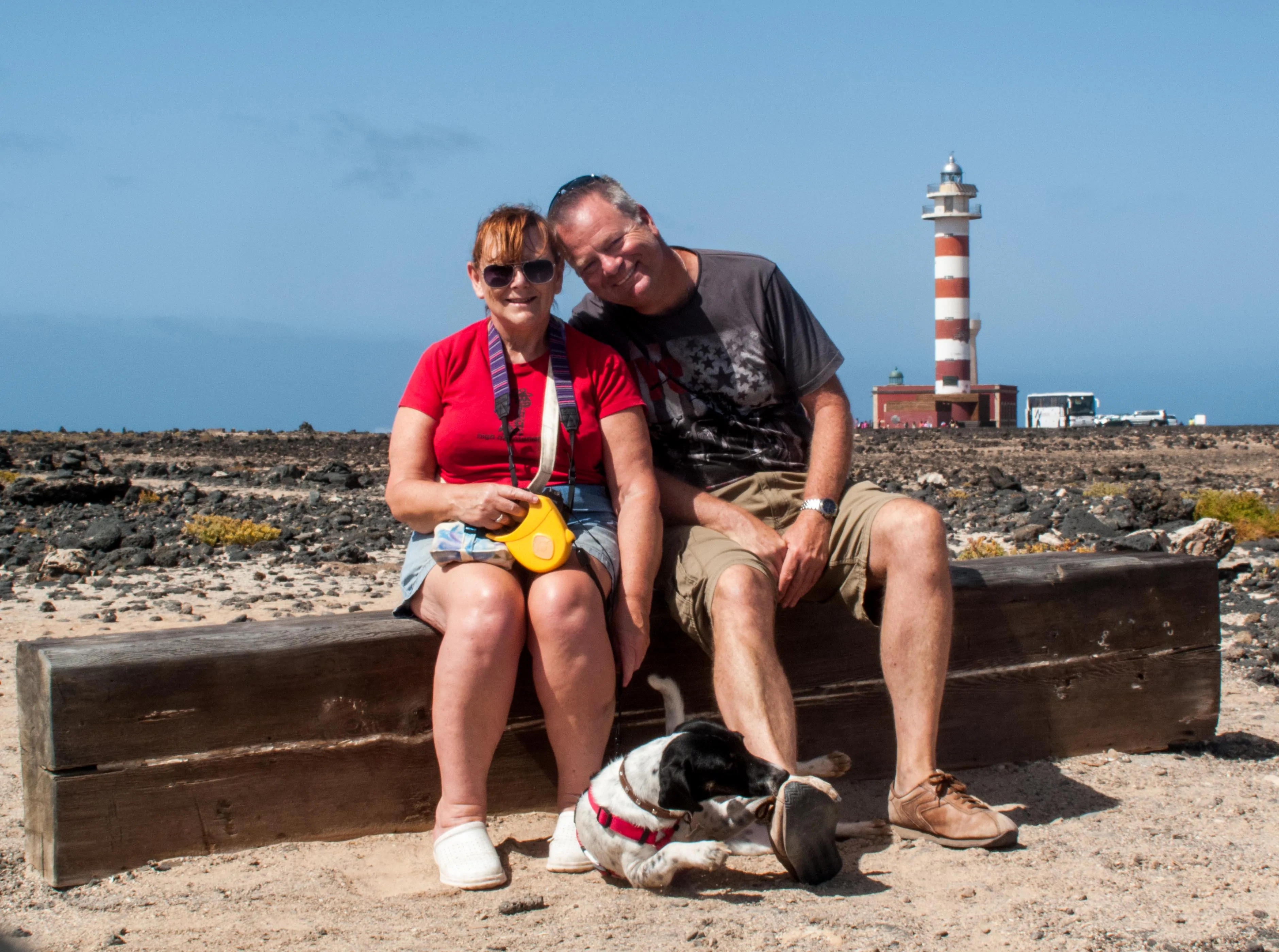
I have been holidaying in Fuerteventura for over 30 years and have been living here full time since 2013. I have a popular Youtube channel related to this website called JP in Fuerteventura
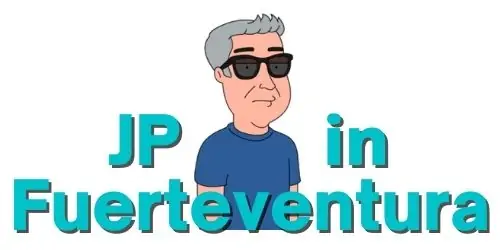



Leave a Reply